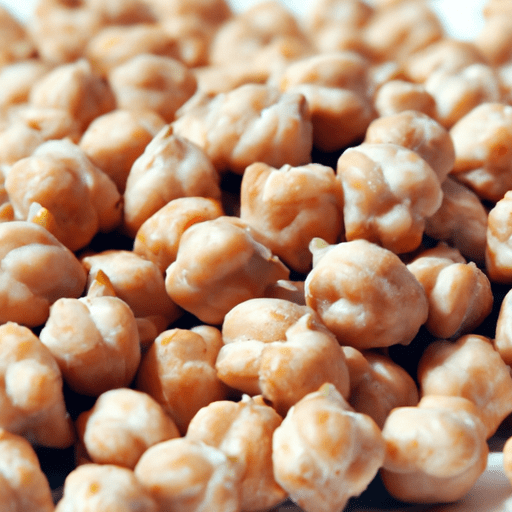The Versatile and Nutritious Dried Garbanzo Beans
Dried garbanzo beans, also known as chickpeas, are a culinary delight that have been enjoyed across cultures for centuries. These small, beige legumes have a unique taste, incredible versatility in the kitchen, and a nutritional profile that makes them a favorite among health-conscious individuals. Join me as we explore the world of dried garbanzo beans, from their rich history to their countless cooking possibilities.
A Taste and Texture Worth Savoring
Dried garbanzo beans have a distinct nutty and mildly earthy flavor. Their texture is toothsome and creamy, making them a delight to indulge in whether incorporated into a hearty stew or roasted and served as a crispy snack. This unique taste makes dried garbanzo beans a culinary star in various cuisines.
Endless Culinary Possibilities
1. Hummus, a Creamy Delight
One of the most beloved uses of dried garbanzo beans is undoubtedly in the creation of hummus. Originating from the Middle East, hummus is a creamy dip made by blending cooked garbanzo beans with tahini, lemon juice, garlic, and olive oil. This simple yet delicious concoction is perfect as a spread, dip, or a flavorful addition to wraps and sandwiches.
2. Soups and Stews, A Hearty Treat
Dried garbanzo beans add substantial texture and flavor to soups and stews. Whether you’re making a classic Indian Chana Masala, an Italian Pasta e Ceci, or a comforting Moroccan Harira, these beans bring a satisfying creaminess and robustness to the dish.
3. Garbanzo Bean Salad, Fresh and Wholesome
A vibrant garbanzo bean salad is a fantastic summer dish. Combine cooked garbanzo beans with cherry tomatoes, cucumbers, red onions, fresh herbs, and a tangy vinaigrette for a nutritious meal that bursts with delicious flavors. Add feta cheese or avocado for an extra touch of indulgence.
4. Roasted Snack, Crunchy and Addictive
Roasting dried garbanzo beans transforms them into an addictive snack. After boiling and drying them thoroughly, toss them in olive oil, season them with your favorite spices, and roast in the oven until they turn golden brown and crisp. Enjoy them as a healthy alternative to potato chips or popcorn.
A Nutritional Powerhouse
Dried garbanzo beans are not only versatile and delicious, but they are also packed with essential nutrients. They are an excellent plant-based source of protein and dietary fiber, making them a favorite among vegans, vegetarians, and health-conscious individuals. Additionally, they provide a good amount of minerals like iron, magnesium, and potassium, as well as B-vitamins.
Fascinating History and Fun Facts
Dried garbanzo beans have an extensive history that can be traced back more than 7,000 years to their origins in the Middle East. They were cultivated in ancient civilizations such as Egypt and Mesopotamia and have been prominently featured in traditional Mediterranean, Middle Eastern, and South Asian cuisines ever since.
In some cultures, dried garbanzo beans are believed to bring good luck, symbolizing fertility and prosperity. They have been associated with festivals and celebrations, where they are prepared in a variety of delicious dishes shared among families and friends.
In Conclusion
Dried garbanzo beans are a culinary gem that brings both flavor and nutrition to our plates. Whether you’re a devoted foodie, a health enthusiast, or simply someone seeking to diversify your meals, these versatile legumes have something to offer. From the creamy delights of hummus to the hearty warmth of stews, dried garbanzo beans have firmly established themselves as a staple ingredient in countless dishes. So why not embrace their taste and incorporate them into your own culinary adventures?
Dried Garbanzo Beans
- Origin: Dried garbanzo beans, also known as chickpeas, have been cultivated for thousands of years and are believed to have originated in the Middle East, specifically in modern-day Turkey and Iran.
- Common Uses: Dried garbanzo beans are a versatile ingredient used in various cuisines around the world. They are commonly used in soups, stews, curries, and salads. Ground into flour, they are used to make dishes like falafel and hummus.
- Nutritional Benefits: Dried garbanzo beans are highly nutritious. They are a rich source of protein, dietary fiber, and several essential minerals, including iron, phosphorus, magnesium, and potassium. They are also a good source of vitamins, such as folate and vitamin B6. Garbanzo beans are low in fat and cholesterol-free.
- Unique Properties: One unique property of dried garbanzo beans is their versatility in culinary applications. They have a mild, nutty flavor and a creamy texture when cooked, making them suitable for a variety of dishes. Additionally, they can be sprouted, which enhances their nutritional value and adds a fresh crunch to salads and sandwiches.
- Historical Significance: Dried garbanzo beans have a significant historical significance. They have been cultivated for thousands of years and were consumed in ancient civilizations such as the Mesopotamians, Egyptians, Greeks, and Romans. They were widely traded along the Silk Road and were even found in Egyptian tombs, indicating their cultural and dietary importance. Today, garbanzo beans continue to be an essential ingredient in Mediterranean, Middle Eastern, and Indian cuisine.




Use the share button below if you liked it.
It makes me smile, when I see it.